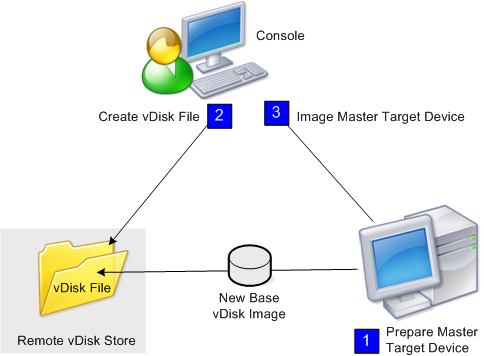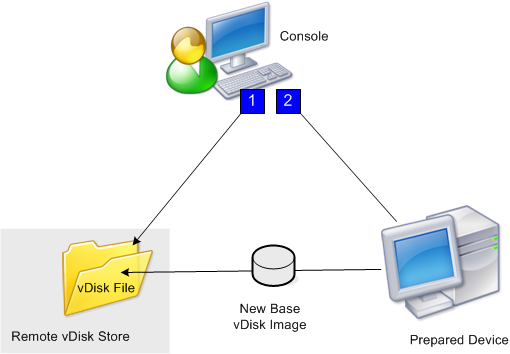-
-
Creating vDisks
-
Selecting the write cache destination for standard vDisk images
-
-
-
Deploying virtual desktops to VMs using the XenDesktop Setup Wizard
This content has been machine translated dynamically.
Dieser Inhalt ist eine maschinelle Übersetzung, die dynamisch erstellt wurde. (Haftungsausschluss)
Cet article a été traduit automatiquement de manière dynamique. (Clause de non responsabilité)
Este artículo lo ha traducido una máquina de forma dinámica. (Aviso legal)
此内容已经过机器动态翻译。 放弃
このコンテンツは動的に機械翻訳されています。免責事項
이 콘텐츠는 동적으로 기계 번역되었습니다. 책임 부인
Este texto foi traduzido automaticamente. (Aviso legal)
Questo contenuto è stato tradotto dinamicamente con traduzione automatica.(Esclusione di responsabilità))
This article has been machine translated.
Dieser Artikel wurde maschinell übersetzt. (Haftungsausschluss)
Ce article a été traduit automatiquement. (Clause de non responsabilité)
Este artículo ha sido traducido automáticamente. (Aviso legal)
この記事は機械翻訳されています.免責事項
이 기사는 기계 번역되었습니다.책임 부인
Este artigo foi traduzido automaticamente.(Aviso legal)
这篇文章已经过机器翻译.放弃
Questo articolo è stato tradotto automaticamente.(Esclusione di responsabilità))
Translation failed!
Creating vDisks
This section provides the information and tasks necessary to create a new base vDisk image.
vDisks act as a hard disk for a target device and exist as disk image files on a Provisioning Server or on a shared storage device. A vDisk consists of a VHDX base image file, any associated properties files (.pvp), and if applicable, a chain of referenced VHDX differencing disks (.avhdx).
When creating a vDisk image file, keep the following facts in mind:
- You can create as many vDisk image files as needed, as long as you have enough space available on the Provisioning Server, or on the storage device containing the vDisk image files.
- vDisk files use FAT or NTFS file systems for Microsoft operating systems.
- Depending upon the file system used to store the vDisk, the maximum size of a VHDX file (vDisk) is 2 terabytes (NTFS) or 4096MB (FAT).
- A vDisk may be shared (Standard Image) by one or more target devices, or it can exist for only one target device to access (Private Image).
Creating a new vDisk is the first stage in the lifecycle of a vDisk. To create a vDisk basically requires preparing the master target device for imaging, creating and configuring a vDisk file where the vDisk will reside, and then imaging the master target device to that file; resulting in a new base vDisk image. This process can be performed automatically, using the Imaging Wizard, or manually. Provisioning Services also provides the option to create a commom image for use with a single target platform or for use with multiple target platforms.
Note
Your administrator role determines what displays and which tasks you can perform in the Console. For example, you can view and manage vDisks in sites in which you are a site administrator. However, unless the farm administrator sets a site as the owner of a store, the site administrator can not perform store management tasks.
Tip
Citrix only supports automated vDisk capture; additional steps require a vDisk attached to the machine being captured (which ensures that a P2PVS switch can be used with P2PVS or ImagingWizard). Use automation steps to accommodate such scenarios.
The following provides an overview of the steps necessary to create a vDisk automatically and manually.
Automatically creating a vDisk image using the Imaging Wizard
This is the recommended method for creating new vDisk images.

Note: The master target device, physical or virtual, is prepared by installing and configuring the operating system of choice, as well as any applications that should be included in the base vDisk image. For details, refer to Preparing the Master Target Device.
To image the master target device, run the Imaging Wizard to automatically create a new vDisk file on a Provisioning Server or shared storage, and then image the master target device to that file.
Manually creating a vDisk file then creating the image using Provisioning Services imaging
This is the optional method used to create new vDisk images. 
- The master target device, physical or virtual, is prepared by installing and configuring the operating system of choice, as well as any applications that should be included in the base vDisk image. A vDisk file is then created on a Provisioning Server or shared storage, which can be accessed by any Provisioning Server that will provide the vDisk. The file must be mounted, formatted, then unmounted manually. This can be accomplished from the Console or from the target device. Note: In the Console, a new vDisk file can be created by right-clicking on the vDisk Pool or the Store, and then selecting the Create new vDisk menu option. Once created, vDisks display in the details pane when a site’s vDisk pool is selected, or when a store in the farm is selected.
- The master target device is imaged to the new vDisk file using the Provisioning Services imaging utility. Note: As a physical to virtual conversion tool, the imaging utility can convert a server or desktop workload from an online physical machine running Windows to a XenServer virtual machine or Provisioning Services vDisk. As a virtual-to-virtual tool, the imaging utility can convert a server or desktop workload from an offline virtual machine or disk, containing any guest operating system, to a XenServer VM.
Share
Share
In this article
This Preview product documentation is Citrix Confidential.
You agree to hold this documentation confidential pursuant to the terms of your Citrix Beta/Tech Preview Agreement.
The development, release and timing of any features or functionality described in the Preview documentation remains at our sole discretion and are subject to change without notice or consultation.
The documentation is for informational purposes only and is not a commitment, promise or legal obligation to deliver any material, code or functionality and should not be relied upon in making Citrix product purchase decisions.
If you do not agree, select Do Not Agree to exit.